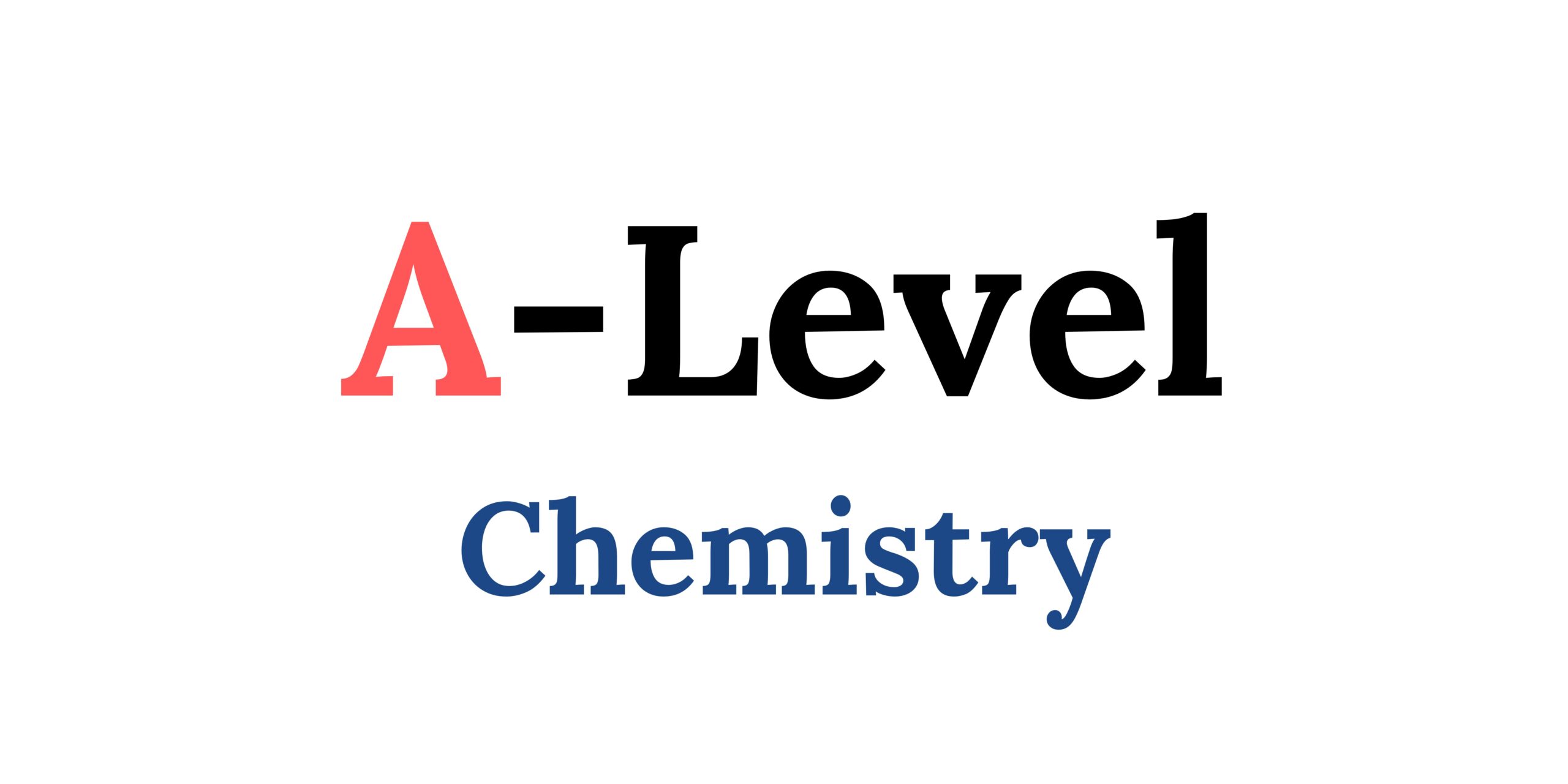
Overview of AQA A-level Chemistry qualifications
Subject content:
Want to learn more about Advanced Level Qualifications (A-Levels) and how they can shape your academic future? Click here to explore: A-Level Information.
Physical chemistry
| Syllabus component | Content |
|---|---|
| Atomic structure | • Fundamental particles • Mass number and isotopes • Electron configuration |
| Amount of substance | • Relative atomic mass and relative molecular mass • The mole and the Avogadro constant • The ideal gas equation • Empirical and molecular formula • Balanced equations and associated calculations |
| Bonding | • Ionic bonding • Nature of covalent and dative covalent bonds • Metallic bonding • Bonding and physical properties • Shapes of simple molecules and ions • Bond polarity • Forces between molecules |
| Energetics | • Enthalpy change • Calorimetry • Applications of Hess’s law • Bond enthalpies |
| Kinetics | • Collision theory • Maxwell–Boltzmann distribution • Effect of temperature on reaction rate • Effect of concentration and pressure • Catalysts |
| Chemical equilibria, Le Chatelier’s principle and Kc | • Chemical equilibria and Le Chatelier’s principle • Equilibrium constant Kc for homogeneous systems |
| Oxidation, reduction and redox equations | • Oxidation • Reduction • The rules for assigning oxidation states |
| Thermodynamics | • Born–Haber cycles • Gibbs free-energy change, ∆ G, and entropy change, ∆ S |
| Rate equations | • Reaction order and rate constant • Calculations using the rate equation • Determination of rate equation |
| Equilibrium constant Kp for homogeneous systems | • Partial pressure from mole fraction and total pressure • Expression for Kp for a homogeneous system in equilibrium • Calculations using Kp |
| Electrode potentials and electrochemical cells | • Electrode potentials and cells • Commercial applications of electrochemical cells |
| Acids and bases | • Brønsted–Lowry acid–base equilibria in aqueous solution • Definition and determination of pH • The ionic product of water, Kw • Weak acids and bases Ka for weak acids • pH curves, titrations and indicators • Buffer action |
Inorganic chemistry
| Syllabus component | Content |
|---|---|
| Periodicity | • Classification in the Periodic Table • Physical properties of Period 3 elements |
| Group 2, the alkaline earth metals | • The trends in atomic radius, first ionisation energy and melting point of the elements Mg–Ba • The reactions of the elements Mg–Ba with water. • The use of magnesium in the extraction of titanium from TiCl4 • The use of BaSO4 in medicine |
| Group 7(17), the halogens | • The trends in electronegativity and boiling point of the halogens • Uses of chlorine and chlorate(I) |
| Properties of Period 3 elements and their oxides | • Reactions of Na and Mg with water. • Trends in reactions of Na, Mg, Al, Si, P, and S with oxygen: formation of Na2O, MgO, Al2O3, SiO2, P4O10, SO2, and SO3. • Melting point trends of the highest oxides of Na–S. • Reactions of Na2O, MgO, Al2O3, SiO2, P4O10, SO2, and SO3 with water and resulting pH. |
| Transition metals | • General properties of transition metals • Substitution reactions • Shapes of complex ions • Formation of coloured ions • Variable oxidation states • Catalysts |
| Reactions of ions in aqueous solution | • Formation of metal-aqua ions in aqueous solution • Acidity |
Organic chemistry
| Syllabus component | Content |
|---|---|
| Introduction to organic chemistry | • Nomenclature • Reaction mechanisms • Isomerism |
| Alkanes | • Fractional distillation of crude oil • Modification of alkanes by cracking • Combustion of alkanes • Chlorination of alkanes |
| Halogenoalkanes | • Nucleophilic substitution • Elimination • Ozone depletion |
| Alkenes | • Structure, bonding and reactivity • Addition reactions of alkenes • Addition polymers |
| Alcohols | • Alcohol production • Oxidation of alcohols • Elimination |
| Organic analysis | • Identification of functional groups by test-tube reactions • Mass spectrometry • Infrared spectroscopy |
| Optical isomerism | • Formation of optical isomers (enantiomers) • Formulas of enantiomers |
| Aldehydes and ketones | • Aldehyde and ketone addition reactions • Chemical tests to distinguish between aldehydes and ketones • Hazards associated with the use of KCN |
| Carboxylic acids and derivatives | • Carboxylic acids and esters • Acylation |
| Aromatic chemistry | • Bonding • Electrophilic substitution |
| Amines | • Preparation • Base properties • Nucleophilic properties |
| Polymers | • Condensation polymers • Biodegradability and disposal of polymers |
| Amino acids, proteins and DNA | • Amino acids • Proteins • Enzymes • DNA • Action of anticancer drugs |
| Organic synthesis | • Formation of new organic compounds by multi-step syntheses using reactions included in the specification • Stages of synthesis of an organic compound |
| Nuclear magnetic resonance spectroscopy | • Methods for structure determination of compounds • Nuclear magnetic resonance spectroscopy method |
| Chromatography | • Types of chromatography |
Assessment
Assessment Objectives:
AO1: Demonstrate knowledge and understanding of scientific concepts, processes, techniques, and procedures.
AO2: Apply knowledge and understanding in:
– Theoretical contexts
– Practical contexts
– Handling qualitative data
– Handling quantitative data
AO3: Analyse, interpret, and evaluate scientific information to:
– Make judgements and reach conclusions
– Develop and refine practical designs and procedures
| Type of assessment | Content | Final score | Weighting of final grade |
|---|---|---|---|
| Paper 1: Short- and long-answer questions | • Relevant physical chemistry topics: Atomic structure, Energetics, Chemical equilibria, Le Chatelier’s principle and Kc, Thermodynamics, Equilibrium constant Kp for homogeneous systems, Acids and bases; • Inorganic chemistry (all topics); • Relevant practical skills. | 105 marks | 35% |
| Paper 2: Short- and long-answer questions | • Relevant physical chemistry topics: Amount of substance, Chemical equilibria, Le Chatelier’s principle and Kc, Rate equations; • Organic chemistry (all topics); • Relevant practical skills. | 105 marks | 35% |
| Paper 3: 40 – marks of questions on practical techniques and data analysis; 20 – marks of questions testing across the specification; 30 – marks of multiple choice questions. | Any content Any practical skills | 90 marks | 30% |
Practical assessments
Practical assessments are divided into those evaluated in written exams and those assessed directly during experiments. A-level grades will be determined solely by written exam marks. A separate endorsement of practical skills, assessed by teachers through direct observation of skills not covered in written exams, will accompany the A-level.
Required practical activities
1. Prepare a volumetric solution and perform a simple acid-base titration.
2. Measure an enthalpy change.
3. Investigate how the rate of a reaction changes with temperature.
4. Conduct simple test-tube reactions to identify:
• Cations: Group 2, NH4+
• Anions: Group 7 (halide ions), OH-, CO3 {2-}, SO4 {2-}
5. Distill a product from a reaction.
6. Test for alcohol, aldehyde, alkene, and carboxylic acid.
7. Measure the rate of reaction:
• By an initial rate method.
• By a continuous monitoring method.
8. Measure the EMF of an electrochemical cell.
9. Investigate pH changes when a weak acid reacts with a strong base and when a strong acid reacts with a weak base.
10. Prepare:
• A pure organic solid and test its purity.
• A pure organic liquid.
11. Conduct simple test-tube reactions to identify transition metal ions in aqueous solution.
12. Separate species using thin-layer chromatography.
If you need help with Chemistry or any other subject, our tutors are ready to support you on your academic journey. Don’t miss your chance to succeed—take a trial lesson today!
Weighting of assessment objectives for A-level Chemistry
| Assessment objectives AOs* | Paper 1 (%) | Paper 2 (%) | Paper 3 (%) | Total Weighting (%) |
|---|---|---|---|---|
| AO1 | 30 | 30 | 32 | 30 |
| AO2 | 48 | 48 | 34 | 45 |
| AO3 | 22 | 22 | 34 | 25 |
| Total weight of components | 35 | 35 | 30 | 100 |
Assessment weightings
Marks will be scaled to meet component weightings. Final marks are the sum of scaled component marks. Grade boundaries are set using total scaled marks.
| Сomponent | Maximum raw mark | Scaling factor | Maximum scaled mark |
|---|---|---|---|
| Paper 1 | 105 | ×1 | 105 |
| Paper 2 | 105 | ×1 | 105 |
| Paper 3 | 90 | ×1 | 90 |
| Total scaled mark: | 300 |











